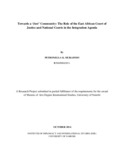| dc.description.abstract | The research study,
Towards a
‘
just
’
Community
: The role of the E
ast
A
frican
C
o
urt of Justice
and n
ational c
ourts in the i
ntegrati
on agenda
,
comes
at an opportune
moment as
Partner States
of
the
East
African Community (EAC) immerse
themselves
deeper into the Community pool
and
oar
their
way
towards the ultimate prize; a political federation. A departur
e
from previous studies
whose main
focus
has been
the
C
ourt’s
jurisdictional limitations in areas such as human rights
and commercial matters,
this research study
goes a step further to r
ec
ognise the significant role
of
n
ati
onal c
ourts
of Partner States
in
EAC’s integration process
and their symbiotic relationship
with the regional Court
.
The study proceeds from th
e premise that the
East African Court o
f
Justice (
EACJ
)
is pivotal
to the
achievement
of the Community’s objects and that the regional
Court is not an island situated at Arusha;
its effectiveness being largely dependent on other
actors and factor
s such as national judiciaries and
citizens of Partner states.
The same case
applies to governments of Partner States wit
hout whose political
g
ood will, the institutions and
o
rgans of th
e C
ommunity
such as
the EACJ would
be unable to optimally discharge their
respective mandates
under the Treaty
,
hence derailing the integration process
.
The study acknowledges that
jurisdiction is
s
ometimes not everything.
There are other variables
that wi
ll determin
e
the
success of the
EACJ
in shaping Community policies and ultimately in
meeting
Community objects as set out under the EAC Treaty
.
The author for instance notes that
lack of express
human rights
jurisdiction in the EAC Treaty
has not deterred
the
EACJ
from
adjudicating on matters touching on human rights
,
through
progressive
interpretation of
existent
Treaty provisions
in cases
presented
before i
t. Furthermore, the underutilis
ation of some of the
already
existing
j
urisdiction in areas such as
arbitration and preliminary references implies that
there is more to the equation than mere articulation of jurisdiction on paper. Sometimes the
answers to bigger problems lie in simple solutions
. For instance, ultimately,
potential consumers
of justice
h
ave to be aware of the Court’s mandate
and be willing to file cases
before the regional
C
ourt.
The Court
must in addition
possess the requisite
capacity to process
the
array of legal
issues in which it has
jurisdiction
and its
O
rders must be
implemented an
d enforced
for
the Court
to have the desired impact
.
The study
thus
explores some of the
threats and challenges fac
ing the
EACJ and also
some of the
opportunities
and possible solutions
.
Anchored
mainly on
the
EAC
Treaty
,
supplemented by
case law,
policy documents
,
papers,
reports
coupled with
comparative
pe
rspectives
and stimulating discussions, the study steers
the debate rega
rding the role of the
regional C
ourt towards
more practical issues;
areas seemingly ‘obvious’ yet oft
-
overlooked. | en_US |

